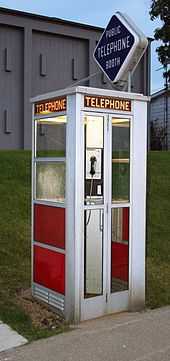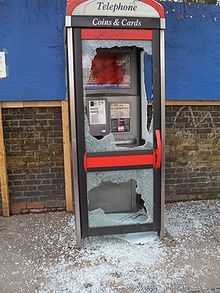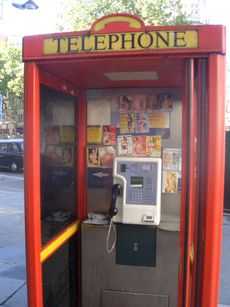Telephone booth

A telephone booth, telephone kiosk, telephone call box, telephone box or public call box[1][2] is a small structure furnished with a payphone and designed for a telephone user's convenience. In the USA and in some parts of Canada, "telephone booth" (or "phone booth") is the commonly used term for the structure, while in the Commonwealth of Nations (particularly the United Kingdom and Australia, and most of Canada) it is a "telephone box" (or "phone box").[3]
Such a booth usually has lighting, a door to provide privacy, and windows to let others know if the booth is in use. The booth may be furnished with a printed directory of local telephone numbers, and a booth in a formal setting, such as a hotel, may be furnished with paper and pen and even a seat. An outdoor booth may be made of metal and plastic to withstand the elements and heavy use, while an indoor booth (once known as a silence cabinet) may have more elaborate architecture and furnishings.[4] Most outdoor booths feature the name and logo of the telephone service provider.
History

In 1889, William Gray is credited with inventing the payphone in the United States, and George A, Long was its developer.[5] The first telephone booth in London, England was probably installed near the Staple Inn in High Holborn in May 1903. It was operated and located by the Grand Central Railway. However, some sources claim that there was a telephone box called "Fernsprechkiosk" in Berlin in 1881.
In the UK, the creation of a national network of telephone boxes commenced in 1920 starting with the K1 which was made of concrete.
Design
Starting in the 1970s pay telephones were less and less commonly placed in booths in the United States. In many cities where they were once common, telephone booths have now been almost completely replaced by non-enclosed pay phones. In the United States, this replacement was caused, at least in part, by an attempt to make the pay telephones more accessible to disabled people. However, in the United Kingdom, telephones remained in booths more often than the non-enclosed set up. Although still fairly common, the number of phone boxes has declined sharply in Britain since the late 1990s due to the boom of mobile phones.
Many locations that provide pay-phones mount the phones on kiosks rather than in booths—this relative lack of privacy and comfort discourages lengthy calls in high-demand areas such as airports.
Special equipment installed in some telephone booths allows a caller to use a computer, a portable fax machine, or a telecommunications device for the deaf.
Paying for the call
Coins
The user of the booth pays for the call by depositing coins into a slot on the telephone. With some telephones the deposit is made before making the call, and the coins are returned if the call attempt is unsuccessful (busy, no answer, etc.). With other types of telephone coins are not deposited until the call has been made and the caller hears their party answer. The deposit of coins then permits two-way conversation to proceed.
Cards
Calls may be paid for by entering a payment code on the telephone's keypad, by swipe-card ("Swipe & Call") or by using a telephone card. Some pay phones are equipped with a card reader that allows a caller to make payment with a credit card.
Collect call
A caller who possesses no means of payment may have the phone company's operator ask the call recipient if the recipient is willing to make payment for the call; this is known as "reversing the charges", "reverse charged call" or a "collect call". It is also sometimes possible to place a call to a phone booth if the intended recipient is known to be waiting at the booth, but not all phone booths allow such incoming calls. Long before "computer hacking" was a common phenomenon, creative mischief-makers devised tactics for obtaining free phone usage through a variety of techniques, including several for defeating the electro-mechanical payment mechanisms of telephone booths—early methods of phone phreaking.
Emergency calls
All payphones require dial-tone first services, allowing coinless access to the emergency telephone number and the switchboard operator, and do not require any coins or credit card payments for dialing such calls (Verizon New York Inc. v. Environmental Control Board of the City of New York, New York State Appellate Division First Department December 29, 2009).
Recent developments




Wireless services
The increasing use of mobile phones has led to a decreased demand for pay telephones, but the increasing use of laptops is leading to a new kind of service. In 2003, service provider Verizon announced that they would begin offering wireless computer connectivity in the vicinity of their phone booths in Manhattan. As of 2006 the Verizon wifi telephone booth service was discontinued in favor of the more expensive Verizon Wireless's EVDO system.[6] This allows a computer user to connect with remote computer services by means of a short range device stationed within the booth. The caller pays for usage by means of a pre-arranged account code stored inside the caller's computer. Wireless access is motivating telephone companies to place wireless stations at locations that have traditionally hosted telephone booths, but stations are also appearing in new kinds of locations such as libraries, cafés, and trains. Phone booths have been slowly disappearing since the advent of the mobile phone in 1973. Most of those that remain stand as symbols of other eras, overrun with graffiti, sticky with secretions. Others have been resurrected, re-purposed by needs as much spiritual and aesthetic as practical.[7]
Vandalism
A rise in vandalism in certain regions has prompted several companies to manufacture simpler booths with extremely strong pay-phones.
Dual currencies
Most telephone booths in Northern Ireland are able to accept two currencies. They are able to accept both pound sterling and euro, due to the proximity to the Republic of Ireland. Similarly, mainly in large cities in Great Britain, certain telephone booths accept both sterling and euro. Other services provided by these booths are internet access, SMS text messaging and ordinary phone services.
Withdrawal of services
Pay phones may still be used by mobile/cellular phone users if their phones become unusable, get stolen, or for other emergency uses. These uses may make the complete disappearance of pay phones in the near future less likely. Often, at least in emergency, a phone call can be made from a hotel or a shop, making public pay phones less needed.
Finland
By 2007, Finnet companies and TeliaSonera Finland had discontinued their public telephones, and the last remaining operator Elisa Oyj did that during the beginning of that year.[8]
Great Britain
The telephone company BT is steadily removing public telephone kiosks from the streets of Great Britain. It is permitted to remove a kiosk without consultation provided that there is another kiosk within 400 metres walking distance. In other cases, it is supposed to comply with Ofcom rules on consultation with the local authority.[9]
Jordan
In 2004, Jordan became the first country in the world not to have telephone booths generally available. The mobile/cellular phone penetration in that country is so high that telephone booths have hardly been used at all for years. The two private payphone service companies, namely ALO and JPP, closed down, and currently there's no payphone service to speak of.[10]
Sweden
The first telephone booth in Sweden was erected in 1890. In 1981 there were 44,000 of them,[11] but in 2013 only 1,200, with a withdrawal of the last one expected in 2015.[12] A survey showed that in 2013 only 1 % of the population in Sweden used one the last year.[12]
Smoking ban
Following the commencement of the smoking ban in England in 2007, it became illegal to smoke in red telephone boxes (types K2 to K8), due to these boxes being completely enclosed spaces. The smoking ban requires owners to display no smoking signs, which has resulted in BT displaying a no smoking sticker which refer to the telephone box as "premises". Despite smoking in red telephone boxes being banned, smoking in other telephone boxes remains legal as these boxes are not completely enclosed spaces.
Charging points
Since many telephone boxes tend to be at the roadside and already have electricity supplies, a trial is to take place in the Spanish capital, Madrid, to convert 30 former telephone boxes into charging points for electric cars.[13]
Advertising
Many telephone boxes in the United Kingdom have become locations for advertisements, bearing posters, with the development of "StreetTalk" by JCDecaux.[14]
In popular culture
- In comic books published by DC Comics, the telephone booth is sometimes (though not always) the place where reporter Clark Kent discards his street clothing and transforms into the costumed superhero Superman. Some of the films and television series featuring the character have also used this plot device.[15]
- The BBC science-fiction television series Doctor Who features the TARDIS, a time machine disguised as a Mackenzie Trench-style police box (a type of phone booth).
- Inspired by Doctor Who, the 1989 film Bill & Ted's Excellent Adventure features a time machine styled after a 1960s American telephone booth.
- In 2002, American cartoonist Jason Shiga produced a series in which an amnesiac must use the materials on hand to survive and figure out why he is trapped within a phone booth in the rubble of a building in a foreign land.
- The 2002 American suspense/psychological thriller film Phone Booth is about a man (Colin Farrell) who is held hostage in a telephone booth by a sniper.
- La cabina is a short film based on a man being trapped in a telephone booth.
- In the 1995 film Hackers the protagonists cyber-harass United States Secret Service Agent Richard Gill by dialing up from several telephone booths in New York City
See also
- Callbox
- Interactive kiosk
- Mojave phone booth
- Payphone
- Police box
- Red telephone box
- KX telephone boxes
- Giles Gilbert Scott, the English architect who designed the iconic red telephone box.
- Phonebooth stuffing
References
| Wikimedia Commons has media related to Telephone booth. |
- ↑ The Plight of the Dartmoor Telephone Boxes
- ↑ Discussion Note on Phone Boxes, Kiosks and ATM machines at Urban Design London
- ↑ Sag, Ivan; Baldwin, Timothy; Bond, Francis; Copestake, Ann; Flickinger, Dan. "Multiword Expressions: A Pain in the Neck for NLP". Stanford University. p. 2. Retrieved 1 June 2012.
- ↑ "Public Telephones". Melchior Telematics. Retrieved December 4, 2007.
- ↑ Site of World’s First Pay Phone
- ↑ Jen Chung (May 2, 2005). "Goodbye Free Verizon WiFi". Gothamist LLC. Retrieved December 4, 2007.
- ↑ Kelly, Ariana. "The Phantom Phone Booth". Los Angeles Review of Books.
- ↑ "Elisa luopuu yleisöpuhelinliiketoiminnasta syksyllä 2007" (in Finnish). Elisa Oyj. November 15, 2006. Retrieved December 4, 2007.
- ↑ http://stakeholders.ofcom.org.uk/binaries/consultations/uso/statement/removals.pdf
- ↑ "Payphones suffer from cellphone growth 2004". CellularOnline. March 22, 2004.
- ↑ Sällsynt telefonkiosk överlever (Swedish)
- ↑ 12.0 12.1 Telefonkiosken tackar för sig
- ↑ Tremlett, Giles (September 8, 2009). "Madrid reverses the chargers with electric car plan". The Guardian.
- ↑ "JCDecaux StreetTalk". JCDecaux. Retrieved September 22, 2011.
- ↑ Younis, Steve. "Superman and the Phone Booth". SupermanHomepage.com. Retrieved July 11, 2013.
External links
- PayPhoneBox Index of payphone numbers and photographs of payphones in unusual or famous places around the world.
- La Cabina at the Internet Movie Database
- Article in Spaces Magazine by Lee Garland, May 08
- Starting the revolution of Phone Booths
- fasse dich kurz -(nimm rücksicht auf wartende)- (ger.)-/-(telefonbox)- .